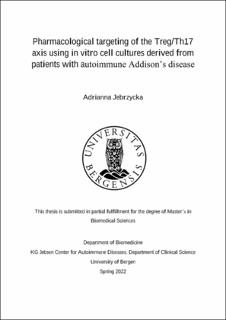| dc.description.abstract | Autoimmune Addison’s disease (AAD) is a rare endocrine disorder characterized by an immune-mediated attack towards the cells of the adrenal cortex. The major self-antigen, targeted by autoantibodies and self-reactive T cells is the enzyme 21-hydroxylase, responsible for the production of life-essential hormones: cortisol and aldosterone. Over time, patients develop hormone insufficiency and depend on life-long hormone replacement therapy, which is currently the only treatment option available. AAD patients suffer from lower quality of life and risk earlier death and as such it is important to find treatment options that target the cause of AAD and not only manage the symptoms. Regulatory T cells (Tregs) are natural immune suppressors that possess a range of immunomodulatory mechanisms to control overt immune responses, promoted by potentially self-reactive T cells. Their reduced numbers and impaired suppressive function are seen in autoimmune conditions, including autoimmune polyendocrine syndromes of which AAD is a frequent component. At the same time, Th17 cells and their signature cytokine IL-17A are frequently involved in the pathogenicity of autoimmune disorders, including psoriasis and rheumatoid arthritis. Intriguingly, peripheral induction of both Tregs and Th17 cells happens in response to TGF-β, and the presence of IL-6 skews this reciprocal interrelation towards Th17 cells. The IL-6R-inhibitor LMT-28 and the monoclonal antibody neutralizing IL-17A Secukinumab, have previously been shown to alter the Treg/Th17 axis by promoting the numbers and function of Tregs. Therefore, they offer an attractive strategy when attempting to restore self-tolerance with the possibility to alleviate or reverse the autoimmune reaction. In this project, we aimed to study the effects of LMT-28 and Secukinumab using in vitro cultures of PBMCs and expanded Tregs from AAD patients and healthy controls. Prior to drug screenings, we optimized the xCELLigence RTCA platform for continuous monitoring of T cells in culture. The subsequent drug screening assays were followed by functional and phenotypical analyses of cells using flow cytometry, quantitative polymerase chain reaction (qPCR,) and enzyme-linked immunosorbent assay (ELISA). Overall, we did not observe major influences of the selected drugs on in vitro cultures of PBMCs and Tregs. Although a slight increase in the number of FOXP3+ Tregs was seen in patients in the expanded LMT-28 treated cultures, these results were not verified on the RNA level. As no differences were observed in the expression levels of Treg and Th17 linage 9 markers FOXP3 and Rorγt following treatments, the Treg/Th17 axis was likely not affected by either of the drugs. As for the effect of the drugs on Treg functional markers, we observed an increase in the protein expression of CD39 in Tregs from healthy controls after both treatments, not seen in AAD patients. The ectoenzyme has been connotated to Tregs with a higher suppressive capacity, indicating that patients’ cells possibly did not respond optimally to this positive alteration of the treatments. To validate this finding, future studies with a larger cohort of patients and healthy controls must be conducted, to draw any firm conclusions about the effects of the in vitro treatments. | |
